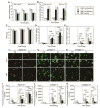Characterization of the chondrocyte secretome in photoclickable poly(ethylene glycol) hydrogels
- PMID: 28436002
- PMCID: PMC5555637
- DOI: 10.1002/bit.26320
Characterization of the chondrocyte secretome in photoclickable poly(ethylene glycol) hydrogels
Abstract
Poly(ethylene glycol) (PEG) hydrogels are highly tunable platforms that are promising cell delivery vehicles for chondrocytes and cartilage tissue engineering. In addition to characterizing the type of extracellular matrix (ECM) that forms, understanding the types of proteins that are secreted by encapsulated cells may be important. Thus, the objectives for this study were to characterize the secretome of chondrocytes encapsulated in PEG hydrogels and determine whether the secretome varies as a function of hydrogel stiffness and culture condition. Bovine chondrocytes were encapsulated in photoclickable PEG hydrogels with a compressive modulus of 8 and 46 kPa and cultured under free swelling or dynamic compressive loading conditions. Cartilage ECM deposition was assessed by biochemical assays and immunohistochemistry. The conditioned medium was analyzed by liquid chromatography-tandem mass spectrometry. Chondrocytes maintained their phenotype within the hydrogels and deposited cartilage-specific ECM that increased over time and included aggrecan and collagens II and VI. Analysis of the secretome revealed a total of 64 proteins, which were largely similar among all experimental conditions. The identified proteins have diverse functions such as biological regulation, response to stress, and collagen fibril organization. Notably, many of the proteins important to the assembly of a collagen-rich cartilage ECM were identified and included collagen types II(α1), VI (α1, α2, and α3), IX (α1), XI (α1 and α2), and biglycan. In addition, many of the other identified proteins have been reported to be present within cell-secreted exosomes. In summary, chondrocytes encapsulated within photoclickable PEG hydrogels secrete many types of proteins that diffuse out of the hydrogel and which have diverse functions, but which are largely preserved across different hydrogel culture environments. Biotechnol. Bioeng. 2017;114: 2096-2108. © 2017 Wiley Periodicals, Inc.
Keywords: cartilage tissue engineering; chondrocyte; hydrogel; poly(ethylene glycol); secretome.
© 2017 Wiley Periodicals, Inc.
Conflict of interest statement
Conflict of interest: All authors declare no conflict of interest
Figures




Similar articles
-
Nondestructive evaluation of a new hydrolytically degradable and photo-clickable PEG hydrogel for cartilage tissue engineering.Acta Biomater. 2016 Jul 15;39:1-11. doi: 10.1016/j.actbio.2016.05.015. Epub 2016 May 11. Acta Biomater. 2016. PMID: 27180026 Free PMC article.
-
An in vitro and in vivo comparison of cartilage growth in chondrocyte-laden matrix metalloproteinase-sensitive poly(ethylene glycol) hydrogels with localized transforming growth factor β3.Acta Biomater. 2019 Jul 15;93:97-110. doi: 10.1016/j.actbio.2019.03.046. Epub 2019 Mar 23. Acta Biomater. 2019. PMID: 30914256 Free PMC article.
-
Spatiotemporal neocartilage growth in matrix-metalloproteinase-sensitive poly(ethylene glycol) hydrogels under dynamic compressive loading: an experimental and computational approach.J Mater Chem B. 2020 Apr 8;8(14):2775-2791. doi: 10.1039/c9tb02963j. J Mater Chem B. 2020. PMID: 32155233 Free PMC article.
-
Mechanical properties of cellularly responsive hydrogels and their experimental determination.Adv Mater. 2010 Aug 17;22(31):3484-94. doi: 10.1002/adma.200904179. Adv Mater. 2010. PMID: 20473984 Free PMC article. Review.
-
Pitfalls and opportunities in the characterization of unconventionally secreted proteins by secretome analysis.Biochim Biophys Acta Proteins Proteom. 2019 Dec;1867(12):140237. doi: 10.1016/j.bbapap.2019.06.004. Epub 2019 Jun 12. Biochim Biophys Acta Proteins Proteom. 2019. PMID: 31202002 Review.
Cited by
-
Infarct Zone: a Novel Platform for Exosome Trade in Cardiac Tissue Regeneration.J Cardiovasc Transl Res. 2020 Oct;13(5):686-701. doi: 10.1007/s12265-019-09952-8. Epub 2020 Jan 6. J Cardiovasc Transl Res. 2020. PMID: 31907784 Free PMC article. Review.
-
Programmable Hydrogels for Cell Encapsulation and Neo-Tissue Growth to Enable Personalized Tissue Engineering.Adv Healthc Mater. 2018 Jan;7(1):10.1002/adhm.201700605. doi: 10.1002/adhm.201700605. Epub 2017 Oct 4. Adv Healthc Mater. 2018. PMID: 28975716 Free PMC article. Review.
-
Polymeric Hydrogels as Mesenchymal Stem Cell Secretome Delivery System in Biomedical Applications.Polymers (Basel). 2022 Mar 17;14(6):1218. doi: 10.3390/polym14061218. Polymers (Basel). 2022. PMID: 35335547 Free PMC article. Review.
-
Stereolithographic 3D Printing for Deterministic Control over Integration in Dual-Material Composites.Adv Mater Technol. 2019 Nov;4(11):1900592. doi: 10.1002/admt.201900592. Epub 2019 Sep 26. Adv Mater Technol. 2019. PMID: 33043126 Free PMC article.
-
Zwitterionic PEG-PC Hydrogels Modulate the Foreign Body Response in a Modulus-Dependent Manner.Biomacromolecules. 2018 Jul 9;19(7):2880-2888. doi: 10.1021/acs.biomac.8b00444. Epub 2018 May 15. Biomacromolecules. 2018. PMID: 29698603 Free PMC article.
References
MeSH terms
Substances
Grants and funding
LinkOut - more resources
Full Text Sources
Other Literature Sources

